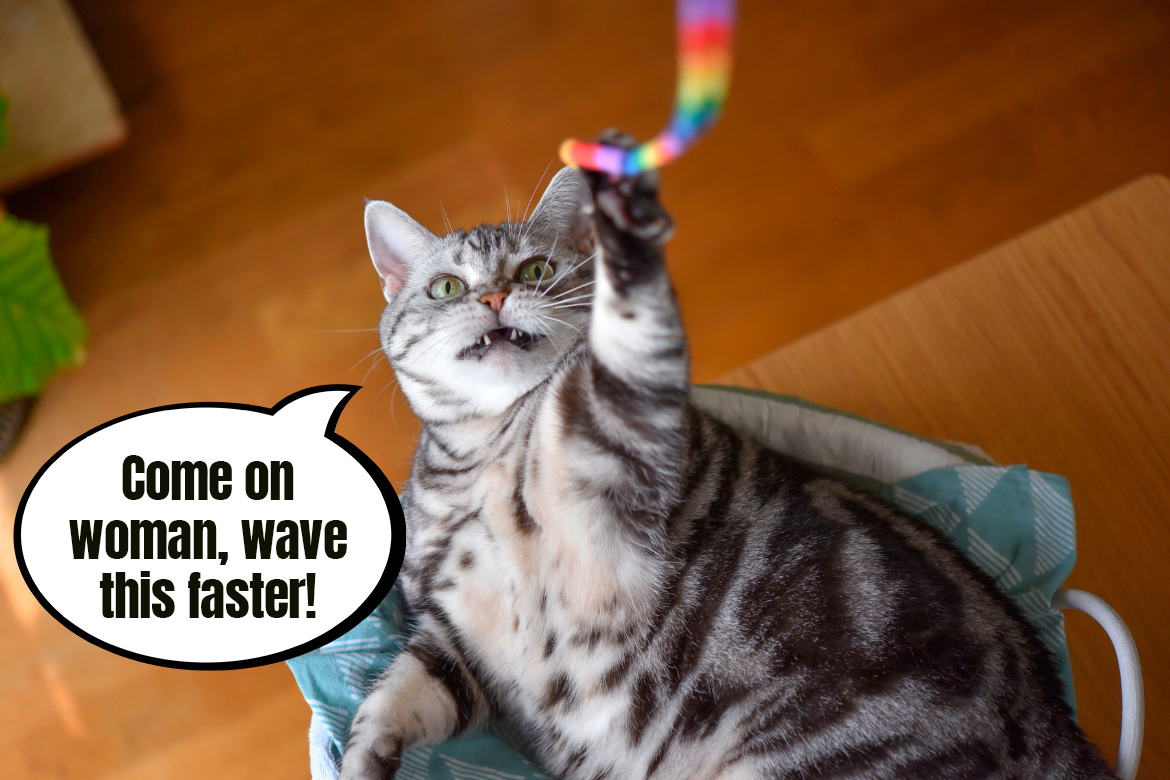Why do cats like to play and will take anything in their paws that can run, hide, roll around or be kicked? The answer is simple, fabCats: good fun is part of cats’ nature! Few weeks old kittens start their first wrestling exercises with small balls, toy mice, feathers and their cat buddies and though with age their playtime preferences might change, one thing stays the same: cats hate to be bored and will do anything to combat that feeling. How can we, cat Carers, make sure that our feline friends always have something to do and kick boredom out the door? Let’s find out.
Playing or hunting?
This is the first question we ask ourselves today as it’s the hunting instinct that makes cats so eager to play. Domestic cats who have lived with people for thousands of years now are still very strongly connected to their wild ancestors. Even though they will always find some yummy food in their bowls and satisfy their hunger easily, cats preserved their strong hunting instincts and they are still happy to hunt, either to find food or for fun. This is one of the reasons why they’re treated as invasive species in some places – their uncontrolled presence outside can be a threat to many ecosystems as cats love to hunt small animals, including endangered species, and can greatly cut their populations. It might seem like they’re not going to harm anything if they’re full and have eaten at home but that couldn’t be further from the truth. The hunting instinct of a cat is too powerful to fight it.
But how does it relate to domestic cats who aren’t going outside? Well, here’s where the need to play comes in and we, as their Carers, should provide our cats opportunities to play to fulfil one of their primary needs. Playing is just as important for cats as eating, using the litter box or sleeping. When cats don’t play, they get bored, frustrated and can start acting in a way we won’t like – destroying our furniture, attacking us or playing with random objects around the house (whether they’re safe or not, the cat doesn’t care). Even 5-10 minutes of active, engaged playtime a day is enough to kick boredom’s butt and make our domestic adventure seeker happy.
How to play with a cat?
It’s a good question too, fabCat, as it’s not just about the act of playing with a cat – we need to play the right way. Throwing a ball that rolls around and stops under the couch or waving the wand toy once or twice and saying: “my cat isn’t interested in it, doesn’t want to play” is, unfortunately, a common mistake. And we know where it comes from! Up until recently there was little information about how to play with cats and only for a few years now behaviorists have started to work on building up awareness among cat Carers. We will give some of that to you today on a silver platter:
Playing with cats should resemble a hunting cycle, focusing on recreating the way cats hunt in the wild. In order to eat, a wild cat has to hunt its prey and only after eating it they can get to grooming and sleeping comfortably. Playtime should also give them that opportunity – let it happen before meals, making your cat stalk their toy, observe it, catch it, play with it and only then give them food or a treat as a prize for their efforts.
Choosing the right toys. Every cat approaches playtime slightly differently and they may like some toys more than others. For one cat, hunting feathers flying through the air and “sitting” on top of the couch, a shelf or a scratcher before they’re ready to fly back up again is more exciting. Others will choose something slithering on the ground – a toy mouse that hides around the corner or a small paper ball that will roll away anytime the cat pats it with their paw. Don’t be afraid to test out different options with your cat and remember to change your toys often – what was fun today may not be as exciting tomorrow, but if you put it away and take it out after two weeks, the excitement will be back.
Observing is a part of the fun. Many attempts of playing with a cat using a wand toy ends with no success because the cat seems not engaged in the game. But are they really not engaged? One of the key aspects of hunting is observation – a cat will watch its prey move, check where it hides, when it stops, when the best time to pounce on it is and only goes to catch it when they predict it’s the best opportunity to succeed. Us, Carers, don’t often get to this point – we move the wand and once we think the cat is not interested at all, we stop the game and go back to our lives. Meanwhile, all it takes is …
To be the prey. Yes, yes, fabCat – when you pick up the wand toy and encourage your cat to play, remember that you are the extension of the stick. When you steer the toy, you need to think like that bird or that mouse that runs away from the cat. Fly high under the ceiling before you decide to drop to the couch. Move your hand slowly and then pick up the speed. Change the tempo, the direction of your movements, hide behind obstacles and let the cat see you before you hide again. That’s what a hunt in the wild would be like and it’s the unexpected that gets the cats’ gears going. They love it.
Don’t get caught. Everytime you play with your cat remember that it’s the wand toy, the feather, the toy mouse or the ball that is their prey. Don’t let your cat hunt your hands or feet – they shouldn’t associate your fingers or hands with hunting and fun. Playing with a cat this way can be cute and tempting, especially when you play with kittens, but if you want to avoid aggression and behavioral issues, it’s best not to let the cat see us as their target. After all, they don’t see the difference between our fingers moving to play with them and moving because we’re writing an important email to our boss.
How to combat feline boredom?
It’s simple! Try to give attention to your cat every day, at least in the morning and the evening, and play with them. It doesn’t have to be a long session where your cat runs around with their tongue sticking out of exhaustion – it’s more important to engage all their senses and get them thinking. Don’t give up once they catch the toy – let them play for a bit and when they lose focus for a moment, let the toy fly away and get your cats attention again. A few cycles like that and your cat will be happy to get on with their life.
And what to do when you’re not at home? Here is where all the interactive toys come to play – boxes and balls your cat has to get treats out of, sniffing mats, puzzles and brain teasers are a must. Scatter them around the house so that your cat has to find them and get through them to get a reward. Also, think about toys with catnip, valerian or… a mix of both, like our KungFu Cat Toy. Kicker toys with some aromeowtic inside will get your cat ready for solo play and they can tire them out just like a real hunt would. What you need to remember though is to never let the cat have access to them 24/7 – every time they finish playing, hide the toy in a ziplock bag to keep the scent fresh.
To combat boredom, get scratchers, cat houses and cat beds involved as well. Your cat works by observing their surroundings (sights outside the window are great and our TOBI scratcher works fantastically as a window sill lounger), but also by napping or stretching on a scratcher. We say that the more choices your cat has, the lesser the chance of them getting bored, though you have to remember, fabCat, that setting the cat beds and scratchers in the right spots is very important here.
Read more about how to place around scratchers and cat beds so that they’re always a hit with your cats: https://blog.mykotty.pl/en/2021/04/12/fabcatstic-faq-getting-the-kitties-used-to-new-cat-beds-scratchers-and-cat-accessories/
Now for you and your cat – how do you fight boredom, fabCat? We’re waiting for your best ideas and unusual playtime activities in the comments.




